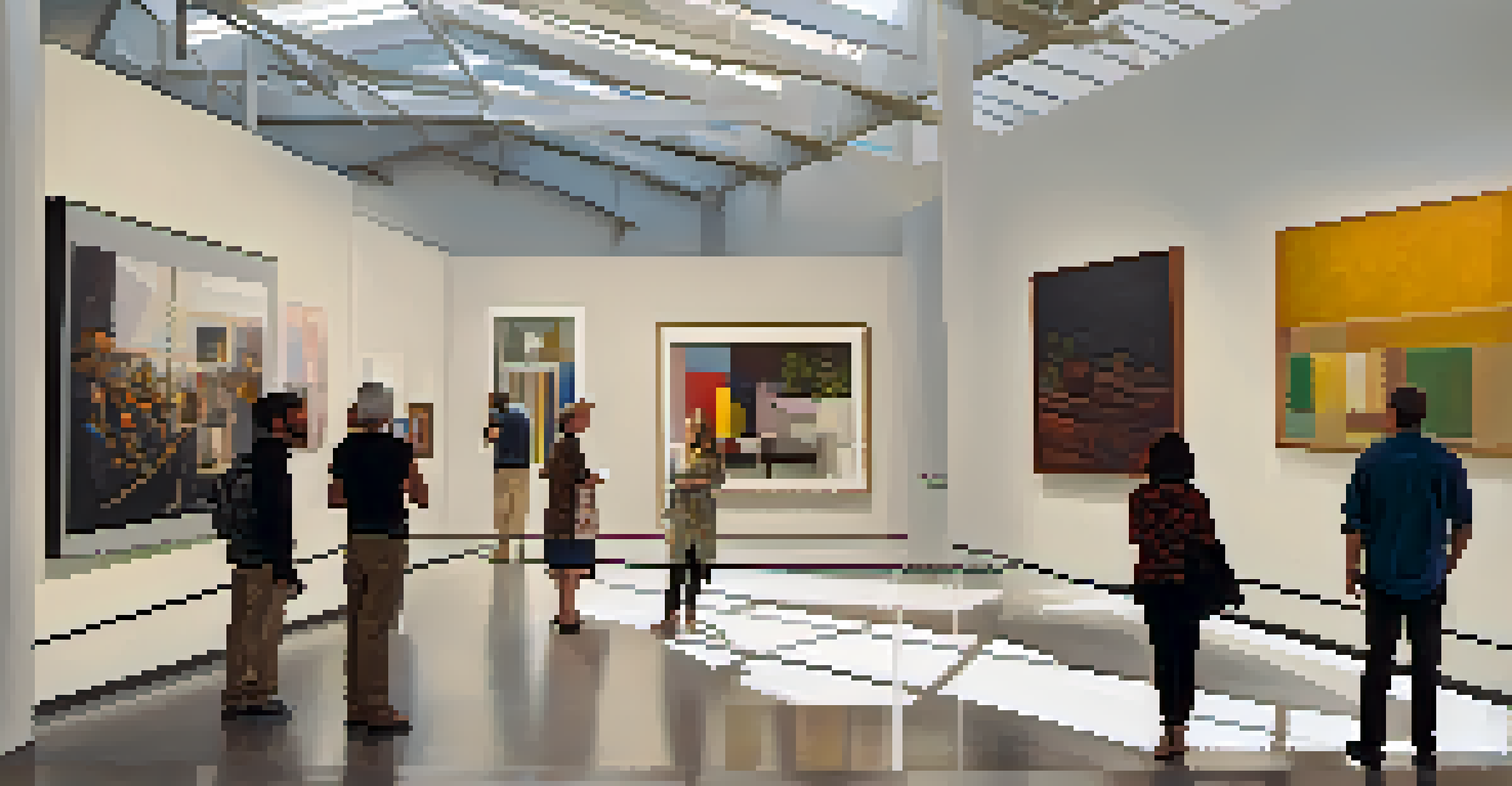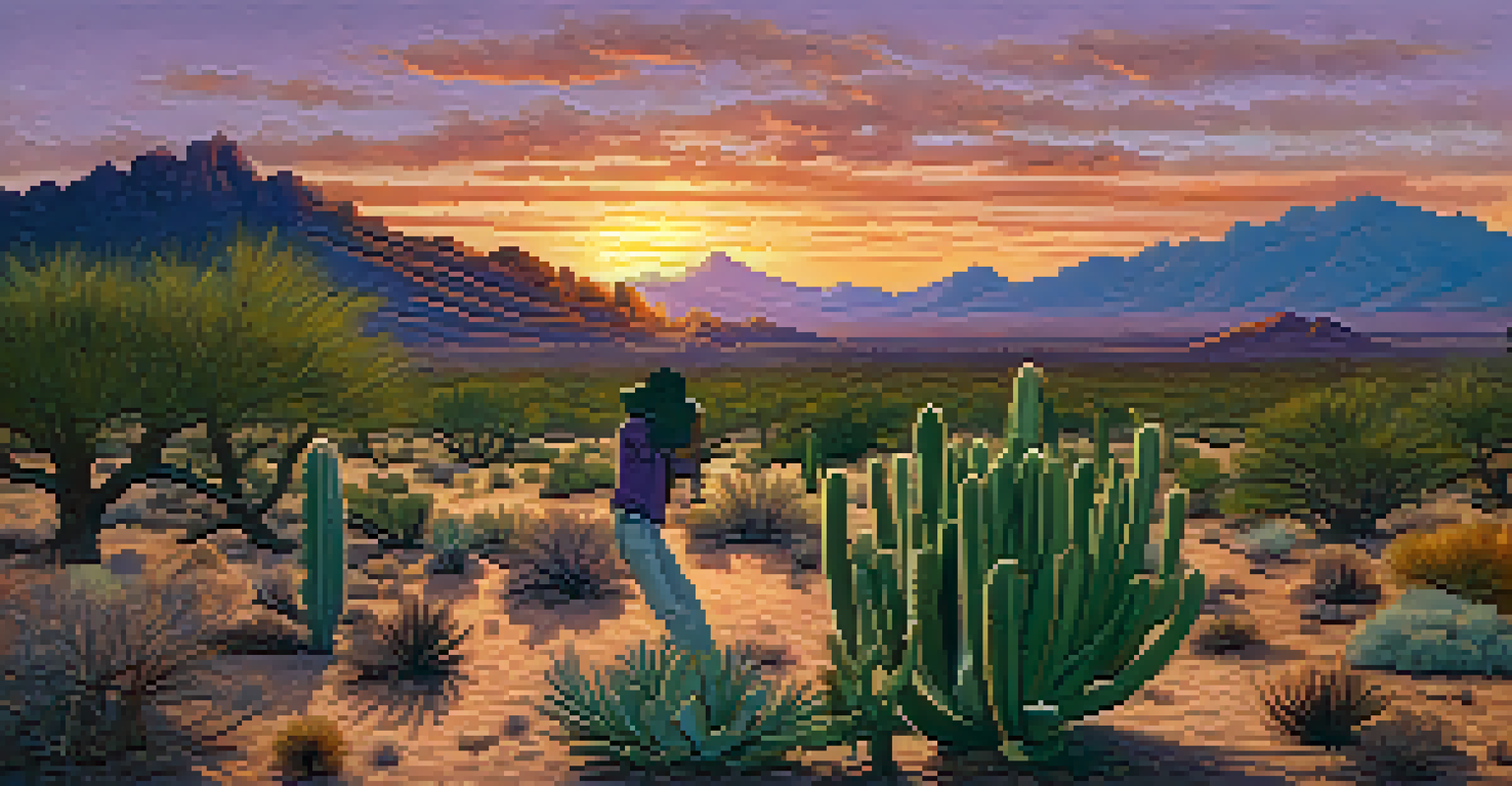Cultural Fusion: Tucson's Role in Shaping Western Art Styles

The Historical Tapestry of Tucson's Art Scene
Tucson's art scene is a vibrant tapestry woven from its rich history. Established as a crossroads for various cultures, it has become a melting pot where Native American, Mexican, and Anglo influences mingle. This blend has shaped a unique artistic identity that reflects the diverse stories of its inhabitants.
Art enables us to find ourselves and lose ourselves at the same time.
Over the centuries, Tucson has attracted artists seeking inspiration from its stunning landscapes and multicultural heritage. The city’s history dates back to the Spanish colonial period, which introduced European artistic traditions. This historical background laid the groundwork for a distinctive art scene that continues to evolve today.
As we explore Tucson’s art, we can see how these historical influences manifest in various styles and mediums. Local artists often draw on their heritage, creating pieces that honor their roots while pushing creative boundaries. This interplay of past and present makes Tucson's art scene a dynamic reflection of its cultural fusion.
The Influence of Native American Art
Native American art plays a crucial role in Tucson's cultural landscape. The region is home to several tribes, including the Tohono O'odham and Pascua Yaqui, whose artistic expressions are deeply rooted in their traditions and spirituality. Their work not only showcases craftsmanship but also tells stories that resonate with both locals and visitors alike.

Artists in Tucson often incorporate Native American motifs and techniques into their own creations, fostering a dialogue between cultures. For example, pottery and weaving techniques are frequently adapted in contemporary art forms, bridging the gap between ancient practices and modern aesthetics. This blending enriches the overall art narrative of the region.
Cultural Fusion Shapes Tucson's Art
Tucson's art scene is a vibrant blend of Native American, Mexican, and Anglo influences, creating a unique artistic identity.
Moreover, art fairs and exhibitions often highlight Native American artists, giving them a platform to share their stories. This exposure helps educate the broader community about their cultural significance and contributes to the preservation of these traditional art forms. The influence of Native American art is a testament to Tucson's commitment to cultural respect and collaboration.
Mexican Heritage and Its Artistic Impact
Tucson's proximity to the border with Mexico has fostered a rich Mexican cultural presence in the arts. This influence is seen in the vibrant colors, themes, and techniques that characterize many local artworks. The city's annual events, like the All Souls Procession, celebrate this heritage through artistic expression, connecting the community to its roots.
Every artist was first an amateur.
Many artists in Tucson draw inspiration from Mexican folk art, incorporating elements like papel picado and vibrant muralism into their work. This fusion creates a unique artistic language that speaks to both local and global audiences. It also highlights the shared histories and struggles of the communities in the region.
Furthermore, Tucson serves as a hub for artists from Mexico and the U.S. to collaborate and share ideas. This cross-pollination of creativity not only enriches the local art scene but also fosters a sense of unity among diverse cultures. The resulting artworks are a beautiful reflection of Tucson’s identity as a cultural crossroads.
The Role of Local Art Institutions
Local art institutions in Tucson play a vital role in promoting cultural fusion. Organizations like the Tucson Museum of Art and the Center for Creative Photography showcase works that highlight the region's diverse artistic influences. These institutions not only exhibit art but also engage the community through educational programs and outreach initiatives.
Exhibitions often feature artists from various backgrounds, providing them with a platform to share their stories. By curating shows that focus on cultural intersections, these institutions encourage dialogue and understanding among different communities. This commitment to inclusivity fosters a rich artistic environment where all voices can be heard.
Urban Murals Reflect Community Identity
Large-scale urban murals serve as public canvases that tell stories of Tucson's diverse heritage, fostering community engagement.
Additionally, workshops and artist residencies hosted by these institutions facilitate collaboration among local and visiting artists. This creative exchange nurtures innovation and allows artists to experiment with new techniques and ideas. The result is an ever-evolving art scene that reflects Tucson's dynamic cultural landscape.
The Impact of Urban Murals on Tucson's Identity
Urban murals have become a defining feature of Tucson's artistic identity. These large-scale works of art adorn buildings throughout the city, often telling stories that reflect its diverse cultural heritage. Murals serve as public canvases that engage the community, transforming everyday spaces into sources of inspiration and pride.
Many of these murals are created by local artists who draw on their personal experiences and cultural backgrounds. This artistic expression not only beautifies the urban landscape but also sparks conversations about identity, history, and social issues. By showcasing these stories publicly, murals invite viewers to reflect on their own connections to the community.
Moreover, the rise of mural festivals in Tucson has attracted national and international artists, further enriching the local art scene. These events highlight the importance of public art as a medium for cultural dialogue. Through murals, Tucson continues to assert its place as a vibrant hub for artistic fusion and expression.
Emerging Artists and New Art Forms
As Tucson's art scene continues to evolve, emerging artists are pushing the boundaries of traditional styles. Many of these artists experiment with mixed media, incorporating digital tools, found objects, and even performance art into their work. This innovative approach reflects the city's dynamic cultural landscape and the diverse influences that shape it.
Young artists often draw on their multicultural backgrounds, infusing their creations with personal narratives that resonate with contemporary audiences. They are not afraid to tackle pressing social issues, using their art as a vehicle for change. This fearless exploration adds depth and relevance to Tucson's artistic identity.
Emerging Artists Redefine Art Forms
Young artists in Tucson are pushing traditional boundaries by incorporating mixed media and addressing contemporary social issues.
The support of local galleries and art collectives is crucial for these emerging talents. By providing spaces for collaboration and experimentation, these organizations nurture creativity and help artists gain visibility. As a result, Tucson's art scene remains vibrant and forward-thinking, continually redefining what it means to be an artist in this culturally rich city.
The Future of Cultural Fusion in Tucson's Art
Looking ahead, the future of cultural fusion in Tucson's art scene appears bright. As more artists from varied backgrounds continue to settle in the city, the potential for creative collaboration expands. This influx of talent fosters an environment where new ideas can flourish, leading to innovative art forms that reflect the complexities of modern identity.
Community initiatives and cultural festivals are likely to play an essential role in shaping this future. These events not only celebrate Tucson's diverse heritage but also encourage intergenerational dialogue among artists and art enthusiasts. By creating spaces for sharing experiences, the community can continue to build on its rich artistic legacy.

Ultimately, Tucson's role in shaping Western art styles will continue to evolve as it embraces its multicultural roots. The ongoing fusion of artistic influences will yield new expressions that resonate with both local residents and a global audience. Tucson stands poised to remain a vibrant center for cultural dialogue and artistic innovation.